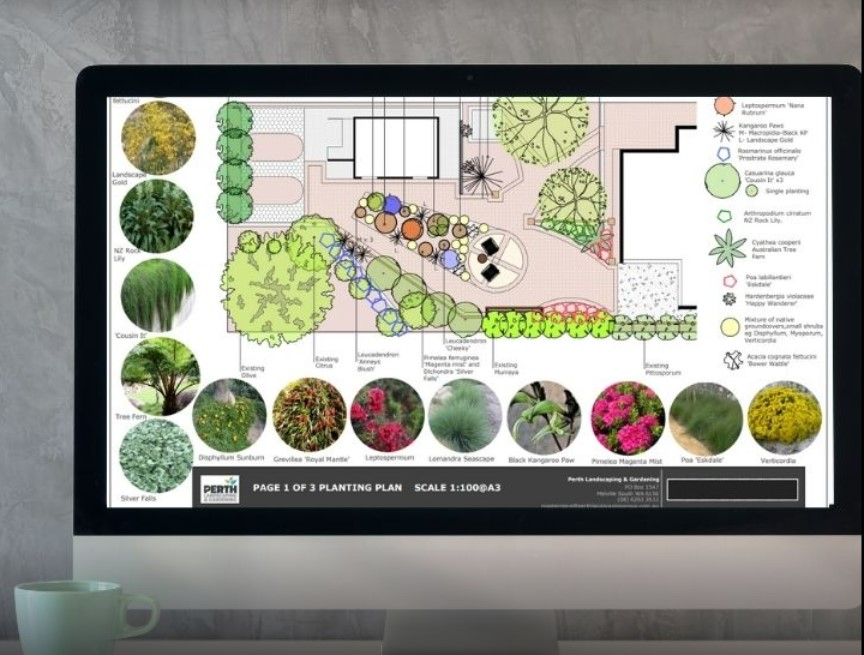Looking to start a landscaping project? You don’t want to make any sort of investment into your property or start a time-consuming project without knowing what you are getting into and the answer to the question “What is landscaping?”
Here is our guide on all you need to know when it comes to landscaping – even if you are a total beginner.
What is Landscaping?
So let’s get straight to the point and start answering the question “what is landscaping?”
Landscaping refers to the process of modifying the visible features of an area of land, including altering the terrain, planting trees and shrubs, installing structures such as patios and walkways, and creating outdoor living spaces. It can also involve designing and maintaining gardens and other areas of plants, as well as managing the overall appearance and functionality of the outdoor space. Landscaping is a popular way to improve the appearance and value of a property, and it can also provide practical benefits such as providing shade, creating privacy, and controlling erosion.
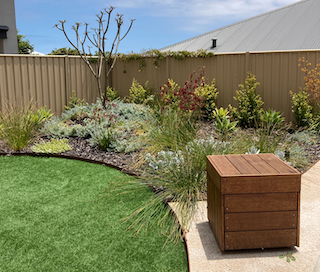
There are many different approaches to landscaping, and the style and design of a landscape will depend on the goals and preferences of the homeowner, as well as the local climate and available resources. Some people may choose to hire a professional landscaper to design and install their landscape, while others may prefer to do the work themselves.
No matter what approach is taken, there are several important considerations to keep in mind when landscaping.
Let’s go more in-depth in this blog to find out more about what landscaping is and its benefits…
Benefits of Landscaping
There are many benefits to landscaping a property, both practical and aesthetic. A well-designed landscape can improve the overall appearance and value of a property, and it can also provide practical benefits such as providing shade, creating privacy, and controlling erosion. Landscaping can also provide an opportunity for outdoor recreation and enjoyment, and it can contribute to the overall health and well-being of the homeowner. Whether you’re a beginner or an experienced landscaper, there are always new things to learn and discover in the world of landscaping.
Some of the many benefits to landscaping a property include:
Improved Appearance
A well-designed and maintained landscape can significantly improve the appearance of a property, making it more attractive and appealing to potential buyers or renters.
Improved Lifestyle
A well-designed landscape can add huge value to the lives of the people who live there! From encouraging the kids to play outside through the use of play spaces and lawn areas, to entertaining areas or relaxed spaces which make spending time at home more enjoyable and fulfilling, your landscape should make your property and outdoors more attractive, livable and lifestyle friendly.
Increased Property Value
Landscaping can also increase the value of a property. A beautiful landscape can make a property more valuable, and it can also increase the resale value of a home.
Practical Benefits
Landscaping can provide practical benefits as well, such as providing shade, creating privacy, and controlling erosion. A landscape may also include outdoor living spaces such as patios and walkways, which can be used for recreation and relaxation.
Improved Health and Well-Being
Landscaping can also have positive effects on the health and well-being of the homeowner. Being surrounded by nature and having access to outdoor spaces can improve mental health and reduce stress, and it can also encourage physical activity.
Environmental Benefits
Landscaping can also have environmental benefits. Planting trees and other vegetation can help to improve air quality and reduce carbon dioxide levels, and it can also provide habitat for wildlife.
Energy Savings
Landscaping can also help to save energy and reduce energy costs. For example, strategically placed trees and shrubs, natural lawn and other green areas can provide shade and an overall cooling effect for your property, which can help to reduce the need for air conditioning in the summer.
Two Key Landscaping Terms
There are two types of landscaping – hardscaping and softscaping.
Hardscaping
When you hear the term ‘hardscaping’ this simply refers to any ‘hard’ landscaping elements such as decking, concrete, paving etc.
Softscaping
You may have guessed based on the above, but ‘softscaping’ refers to the green elements in a landscape; trees, shrubs, flowers and lawn, etc.
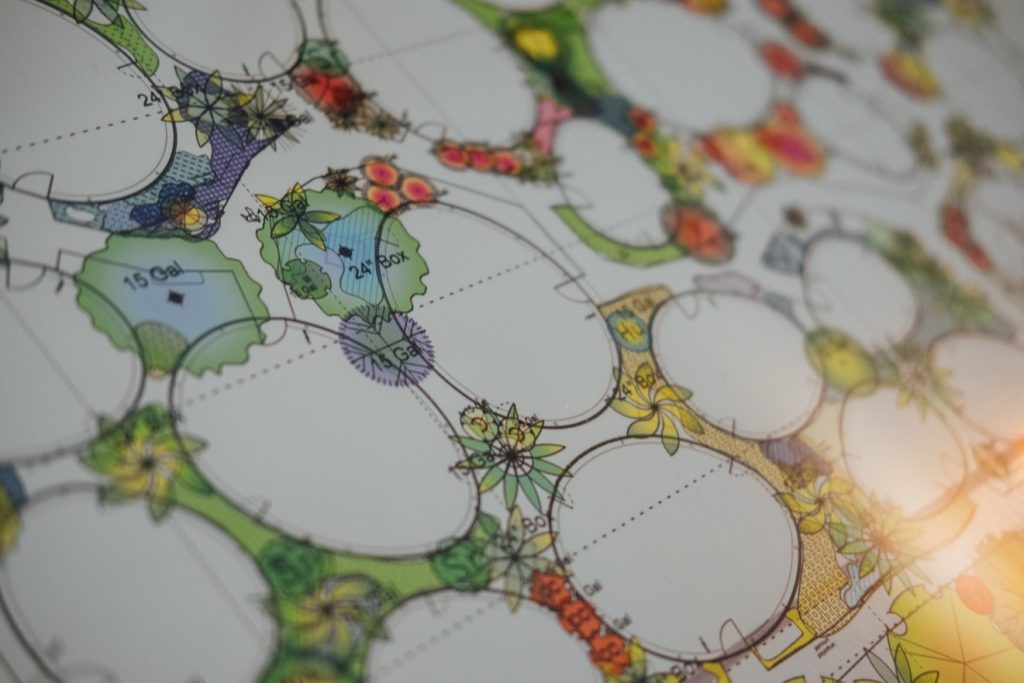
Types of Landscaping Services
While it’s possible to do your own landscaping if you have the time, resources and skills, you’ll get much better results, quicker and of a higher, enduring quality if you enlist the help of an expert Landscaping company like us at Perth Landscaping Experts with our professional team of landscapers.
Landscape Design
No landscaping project should begin without a careful, thorough design and planning process. This makes sure that the end result is a space to enjoy, admire and inspire – ensuring that the landscape is well-suited to the local climate and the needs and goals of the homeowner.
A professional local landscape designer has the training and experience to create a landscape that is both visually appealing and functional. They can provide valuable insights and recommendations based on their knowledge of plant materials, design principles, and local conditions.
A key element that often goes wrong in a DIY landscape is the plant choice. A designer with expert plant knowledge will select plants and other elements that are well-suited to the local climate and soil conditions, which can help to reduce maintenance costs and improve the overall health of the landscape.
Landscape Construction
It’s not enough to design the perfect landscape, you need to be able to construct it with quality results. Using poor quality materials, incorrect site preparation, or cutting corners during landscape construction will leave you with many headaches and problems in the long-run, so it’s best to bring in a professional landscape construction company for this part.
An expert Landscaping company should be able to offer all areas of landscape construction services, including:
Lawns
Lawns are an area of grass that is maintained and kept short. They are often used for recreational purposes such as playing sports or lounging, and they can also provide a nice green backdrop for a landscape. There are many different types of grass that can be used for lawns, and the right lawn choice will depend on the local climate and the desired appearance and maintenance requirements.
Trees
Trees are large, woody plants that are often used in landscaping for their aesthetic value and practical benefits. Choose your landscape trees carefully to make sure that their size, type and root systems are right for each location in your landscaping. Trees can provide shade, create privacy, and improve air quality. They can also provide habitat for wildlife and contribute to the overall health of the environment. Trees can be either deciduous or evergreen, and they can be flowering or non-flowering.
Shrubs
Shrubs are often used in landscaping as hedging or screening plants for their compact size and versatility. Shrubs can be used as border plants, as screens, or as standalone specimens, and they can be found in a variety of shapes, sizes, and colours. Like trees, shrubs can provide shade, create privacy, and improve air quality, and they can also provide habitat for wildlife.
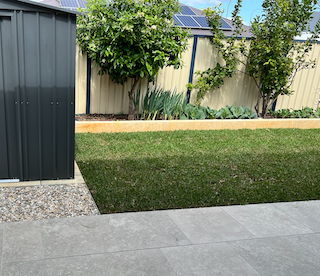
Garden beds
Garden beds are any areas of a landscape that are dedicated to growing plants. These beds can be used to grow a variety of plants, including flowers, vegetables, and herbs. Planting beds can be designed in a variety of shapes and sizes, and they can be raised or ground level.
Water features
Water features are decorative elements in a landscape that incorporate water, such as fountains, ponds, or waterfalls or fountains. Water features can add visual interest to a landscape, and they can also provide a soothing sound and a cool, refreshing environment.
Pathways
Pathways in a landscape that are used for separating areas and providing clear access throughout the landscape. They can be made of a variety of materials, such as concrete, brick, or stone, and they can be straight or winding. Pathways can be used to connect different areas of a landscape, or they can be used as a decorative element. They can also have spaces between them to allow greenery to grow, creating a softer look.
Driveways
Driveways are paved areas that are used for parking or driving vehicles. They can be made of a variety of materials, such as asphalt, concrete, or pavers, and they can be straight or winding. Driveways can be used to provide access to a property or to create an attractive entrance to a home.
Walls
Walls can be used in landscaping for a variety of purposes, such as creating boundaries, providing privacy, or adding visual interest. Walls can be made of a variety of materials, such as stone, brick, or concrete, and they can be found in a variety of styles and sizes. They can also have features such as climbing plants or screens added to soften their look and make them a great backdrop in a landscape.
Fences
Fences can be used in landscaping to create boundaries, provide privacy, or add visual interest. Fences can be made of a variety of materials, such as wood, vinyl, or metal, and they can be found in a variety of styles and sizes. These can also have elements such as screens, climbing frames affixed to them to improve the overall appearance.
Garden Sheds
Garden sheds can be used for storage or as a workspace. They can be made of a variety of materials, such as wood, metal, or plastic, and they can be found in a variety of styles and sizes. Work with your landscape designer to add screening or planting to make them a part of the landscape or hide them so they don’t negatively impact the overall look of the design – but you still get the advantage of additional storage to keep your garden areas tidy.
Decking
There are a myriad of decking options to suit any landscape, from hardwood to composite, or other materials, and they are used for creating additional outdoor living spaces. Decking can be used to create an outdoor living space, such as a patio or a seating area, and it can be found in a variety of styles and sizes.
Styles of Landscaping
Before starting any landscaping, it’s important to decide on the style you want for your property. There are many different types of landscaping, and the style and design of a landscape will depend on the goals and preferences of the homeowner, as well as the local climate and available resources.
If you’re struggling to come up with ideas or make a decision, below are some styles you might consider.
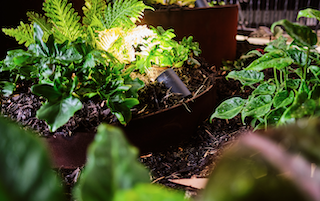
Tropical
Want a lush, tropical landscape to ‘escape’ to? This type of landscaping is characterised by lush, tropical plants and a warm, humid climate. Tropical landscaping design may include elements such as palm trees, exotic flowers, and water features. While trickier to achieve in Perth due to our dry climate and sandy soils, it is still possible with careful planning and soil preparation, along with a great reticulation system and maintenance.
Japanese Garden
The ultimate landscape style for relaxation and a still, zen atmosphere, this type of landscaping is characterised by the use of natural materials such as stone, water, and plants to create a peaceful and serene environment. Japanese garden landscaping may include elements such as waterfalls, koi ponds, and carefully pruned trees and shrubs.
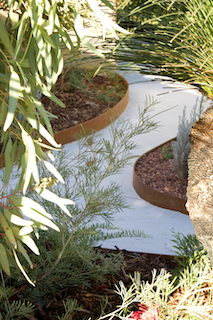
Native
This is our favourite type of landscaping – focusing on using plants that are native to the local area. Perth has a wide range of natives to choose from which are all adapted to the local climate, making it easier to maintain as well as requiring fewer resources to keep healthy. Native landscaping can also help to conserve natural resources and provide habitats for local wildlife. Not to mention – this style of landscape looks amazing!
Desert – or Xeriscape style
This type of landscaping is designed to conserve water, and it is often used in areas with limited water resources – a popular option for us here in Perth. Xeriscape landscaping typically includes drought-resistant plants from the succulent family (such as such as Aizoaceae, Cactaceae, and Crassulaceae), mulch, and efficient irrigation systems. While you might think it would look sparse and boring, these landscapes can look striking while being incredibly easy to maintain!
Formal landscaping
This type of landscaping is characterised by a symmetrical and organised layout, with straight lines and precise shapes. Formal landscaping often includes elements such as formal gardens, topiaries, and carefully manicured lawns. Think Versailles or English mansions – straight from Downton Abbey. This is a very popular modern style but will require a lot of maintenance, so if you aren’t up to it but love the look, make sure you find a great garden maintenance company in Perth to take care of your investment for you.
Informal / Cottage Gardens
Think wildflowers and lush and varied planting. This type of landscaping is more relaxed and natural, with a less formal layout and a focus on native plants and natural materials. Informal landscaping may include elements such as wildflower gardens, natural stone pathways, and meandering streams. These also require expert maintenance to make sure the look stays natural and wild but attractive and true to the design – not overgrown and messy.
These styles are just the tip of the iceberg – the options for landscaping styles are endless. Do plenty of research to find what you like and don’t, then work with a professional landscape designer to customise your look and make the most of your space.
What to Consider Before You Start Landscaping
Along with choosing your landscape design, style and ideal landscaping elements, you need to first think of your goals. Will you be staying in the property forever, or is the landscaping purely to add curb appeal to sell the property? This helps determine the scale of your investment and the complexity of the elements you choose. Also, think about the overall lifestyle requirements. Do you need an entertaining area, pool, play area or relaxation areas? What do you want/need to be able to do outside?
Now that you have a good framework and overall goals, it’s time to think about the details…
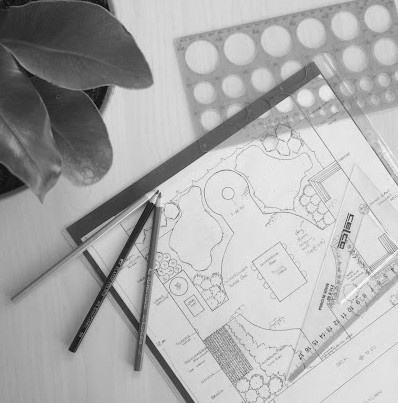
What to Think About When Starting Your Landscaping Project?
- First, it’s important to consider the layout and design of the landscape. This includes determining the overall theme or style of the landscape, as well as deciding on the location of different elements such as plants, trees, and structures. It’s also important to consider the size and scale of the landscape, as well as the surrounding environment and the available sunlight and water resources. Need help with this step? Starting your project with a professional landscape design consultation can get you off to a great start.
- Next, it’s important to choose the right plants and trees for the landscape. This will depend on the local climate and soil conditions, as well as the desired appearance and function of the plants. Some plants may be chosen for their aesthetic value, while others may be chosen for their practical benefits such as providing shade or attracting pollinators. It’s also important to consider the maintenance requirements of different plants, as some may require more care and attention than others.
- In addition to plants, there are many other elements that can be included in a landscape design, such as patios, walkways, and retaining walls. These elements can provide functional benefits such as creating outdoor living spaces or controlling erosion, as well as adding visual interest to the landscape. It’s important to consider the materials and design of these elements, as well as their maintenance requirements and overall cost.
- Once the landscape is designed and installed, it’s important to maintain it to keep it looking its best. This may involve tasks such as watering, pruning, and fertilising plants, as well as controlling pests and weeds. It may also involve regular maintenance of any structures or other elements in the landscape. Whatever you choose to include in your landscape, make sure you think about the maintenance required so that it suits your needs in the long term.
Where to Find Landscaping Ideas
Now that you’ve read our beginners guide explaining what landscaping is, I’m sure you’re eager to get started. So, here are a few tips for where to find good landscaping ideas:
- Observe your friends and families landscaping designs and talk to them about it and the reasons behind what they chose for the style and various features
- Research using magazine, books, television and the internet (you can find some great ideas on Pinterest)
- Get a professional design consultation with a company such as us at Perth Landscaping Experts
- Read landscaping blogs or check out recent design award winners
Ready to Start Your Landscaping Project?
If all of the above has given you some great ideas but also made the idea of your project seem quite overwhelming – don’t hesitate to get in touch with us. We can take you from design to the finished construction and make it easy to build the landscape of your dreams.
Call our friendly team today on (08) 6263 4646 or contact us here to begin.

